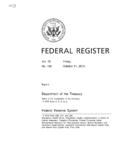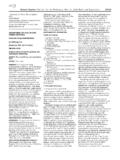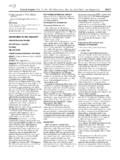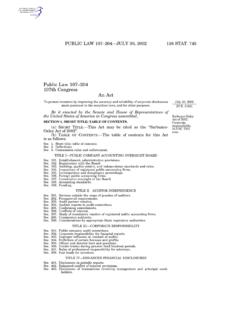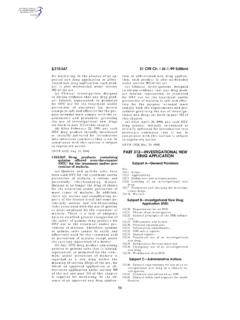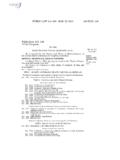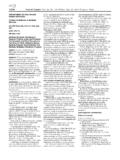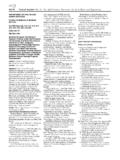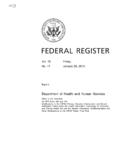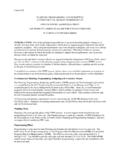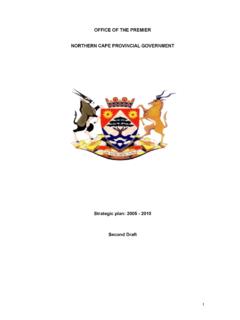Transcription of 74618 Federal Register /Vol. 79, No. 241/Tuesday, …
1 74618 Federal Register / Vol. 79, No. 241 / Tuesday, December 16, 2014 / Rules and Regulations distribution, or use of energy. Because this rule is exempt from review under Executive Order 12866 and is not expected to have a significant adverse effect on the supply, distribution, or use of energy, a Statement of Energy Effects is not required. National Environmental Policy Act This rule does not require an environmental impact statement because section 702(d) of SMCRA (30 1292(d)) provides that agency decisions on proposed State regulatory program provisions do not constitute major Federal actions within the meaning of section 102(2)(C) of the National Environmental Policy Act (42 4332(2)(C) et seq). Paperwork Reduction Act This rule does not contain information collection requirements that require approval by OMB under the Paperwork Reduction Act (44 3501 et seq.). Regulatory Flexibility Act The Department of the Interior certifies that this rule will not have a significant economic impact on a substantial number of small entities under the Regulatory Flexibility Act (5 601 et seq.)
2 The State submittal, which is the subject of this rule, is based upon counterpart Federal regulations for which an economic analysis was prepared and certification made that such regulations would not have a significant economic effect upon a substantial number of small entities. In making the determination as to whether this rule would have a significant economic impact, the Department relied upon the data and assumptions for the counterpart Federal regulations. Small Business Regulatory Enforcement Fairness Act This rule is not a major rule under 5 804(2), of the Small Business Regulatory Enforcement Fairness Act. This rule: a. Does not have an annual effect on the economy of $100 million. b. Will not cause a major increase in costs or prices for consumers, individual industries, Federal , State, or local government agencies, or geographic regions. c. Does not have significant adverse effects on competition, employment, investment, productivity, innovation, or the ability of based enterprises to compete with foreign-based enterprises.
3 This determination is based upon the fact that the State submittal which is the subject of this rule is based upon counterpart Federal regulations for which an analysis was prepared and a determination made that the Federal regulation was not considered a major rule. Unfunded Mandates This rule will not impose an unfunded Mandate on State, local, or tribal governments or the private sector of $100 million or more in any given year. This determination is based upon the fact that the State submittal, which is the subject of this rule, is based upon counterpart Federal regulations for which an analysis was prepared and a determination made that the Federal regulation did not impose an unfunded mandate. List of Subjects in 30 CFR Part 934 Intergovernmental relations, Surface mining, Underground mining. Dated: July 1, 2014. Ervin Barchenger, Acting Director, Western Region. Editorial note: This document was received for publication by the Office of Federal Register on December 10, 2014.
4 For the reasons set out in the preamble, 30 CFR part 934 is amended as set forth below: PART 934 NORTH DAKOTA 1. The authority citation for part 934 continues to read as follows: Authority: 30 1201 et seq. 2. Section is amended in the table by adding a new entry in chronological order by Date of Final Publication to read as follows: Approval of North Dakota regulatory program amendments. * * * * * Original amendment submission date Date of final publication Citation/description ** November 14, 2012 .. December 16, 2014 ..NDAC 69 05 02 NDAC 69 05 08 NDAC 69 06 01 NDAC 69 06 02 NDAC 69 10 01 NDAC 69 10 03 NDAC 69 10 07 NDAC 69 10 08 NDAC 69 10 09 3. Section is republished to read as follows: Required program amendments. Pursuant to 30 CFR (f)(1), North Dakota is required to submit to OSM by the specified date the following written, proposed program amendment, or a description of an amendment to be proposed that meets the requirements of SMCRA and 30 CFR Chapter VII and a timetable for enactment that is consistent with North Dakota s established administrative or legislative procedures.
5 (a) (cc) [Reserved] [FR Doc. 2014 29384 Filed 12 15 14; 8:45 am] BILLING CODE 4310 05 P DEPARTMENT OF COMMERCE United States Patent and Trademark Office 37 CFR Part 1 [Docket No. PTO P 2014 0058] 2014 Interim Guidance on Patent Subject Matter Eligibility AGENCY: United States Patent and Trademark Office, Commerce. VerDate Sep<11>2014 16:25 Dec 15, 2014 Jkt 235001 PO 00000 Frm 00034 Fmt 4700 Sfmt 4700 E:\FR\FM\ 16 DER1tkelley on DSK3 SPTVN1 PROD with RULES74619 Federal Register / Vol. 79, No. 241 / Tuesday, December 16, 2014 / Rules and Regulations 1 Alice Corp. Pty. Ltd. v. CLS Bank Int l, 573 __, 134 S. Ct. 2347 (2014). 2 This analysis differs from the March 2014 Procedure in certain respects. Note, for example, the test for determining whether a claim is directed to a product of nature exception is separated from the analysis of whether the claim includes significantly more than the exception.
6 Also, the application of the overall analysis is based on claims directed to judicial exceptions (defined as claims reciting the exception, , set forth or described), rather than claims merely involving an exception. For instance, process claims that merely use a nature-based product are not necessarily subject to an analysis for markedly different characteristics. Additionally, the markedly different analysis focuses on characteristics that can include a product s structure, function, and/or other properties as compared to its naturally occurring counterpart in its natural state. 3 Association for Molecular Pathology v. Myriad Genetics, Inc., 569 __, 133 S. Ct. 2107 (2013). 4 Mayo Collaborative Serv. v. Prometheus Labs., Inc., 566 __, 132 S. Ct. 1289 (2012). 5 The Court of Appeals for the Federal Circuit has a number of pending appeals that could result in further refinements to the eligibility guidance, including for example, University of Utah Research Foundation v.
7 Ambry Genetics Corp. (In re BRCA1- & BRCA2-Based Hereditary Cancer Test Patent Litigation), No. 14 1361 (Fed. Cir. filed Mar. 18, 2014), and Ariosa Diagnostics, Inc. v. Sequenom, Inc., No. 14 1139 (Fed. Cir. filed Dec. 4, 2013). ACTION: Examination guidance; request for comments. SUMMARY: The United States Patent and Trademark Office (USPTO or Office) has prepared interim guidance (2014 Interim Guidance on Patent Subject Matter Eligibility, called Interim Eligibility Guidance ) for use by USPTO personnel in determining subject matter eligibility under 35 101 in view of recent decisions by the Supreme Court (Supreme Court). This Interim Eligibility Guidance supplements the June 25, 2014, Preliminary Examination Instructions in view of the Supreme Court decision in Alice Corp. (June 2014 Preliminary Instructions) and supersedes the March 4, 2014, Procedure For Subject Matter Eligibility Analysis Of Claims Reciting Or Involving Laws Of Nature/Natural Principles, Natural Phenomena, And/Or Natural Products (March 2014 Procedure) issued in view of the Supreme Court decisions in Myriad and Mayo.
8 The USPTO is seeking public comment on this Interim Eligibility Guidance along with additional suggestions on claim examples for explanatory example sets. DATES: Effective Date: This Interim Eligibility Guidance is effective on December 16, 2014. This Interim Eligibility Guidance applies to all applications filed before, on or after December 16, 2014. Comment Deadline Date: To be ensured of consideration, written comments must be received on or before March 16, 2015. ADDRESSES: Comments on this Interim Eligibility Guidance must be sent by electronic mail message over the Internet addressed to: Electronic comments submitted in plain text are preferred, but also may be submitted in ADOBE portable document format or MICROSOFT WORD format. The comments will be available for viewing via the Office s Internet Web site (http:// ). Because comments will be made available for public inspection, information that the submitter does not desire to make public, such as an address or phone number, should not be included in the comments.
9 FOR FURTHER INFORMATION CONTACT: Raul Tamayo, Senior Legal Advisor, Office of Patent Legal Administration, by telephone at 571 272 7728, or Michael Cygan, Senior Legal Advisor, Office of Patent Legal Administration, by telephone at 571 272 7700. SUPPLEMENTARY INFORMATION: Section 2106 of the Manual of Patent Examining Procedure (MPEP) sets forth guidance for use by USPTO personnel in determining subject matter eligibility under 35 101. See MPEP 2106 (9th ed. 2014). The USPTO has prepared this Interim Eligibility Guidance for use by USPTO personnel in determining subject matter eligibility under 35 101 in view of recent decisions by the Supreme Court. The following Interim Eligibility Guidance on patent subject matter eligibility under 35 101 supplements the June 25, 2014, Preliminary Examination Instructions in view of the Supreme Court Decision in Alice Corporation Pty. Ltd.
10 V. CLS Bank International, et (June 2014 Preliminary Instructions) and supersedes the March 4, 2014, Procedure For Subject Matter Eligibility Analysis Of Claims Reciting Or Involving Laws Of Nature/Natural Principles, Natural Phenomena, And/Or Natural Products (March 2014 Procedure)2issued in view of the Supreme Court decisions in Association for Molecular Pathology v. Myriad Genetics, Mayo Collaborative Services v. Prometheus Laboratories of examination guidance on eligibility will be an iterative process continuing with periodic supplements based on developments in patent subject matter eligibility jurisprudence5and public feedback. The USPTO is seeking written comments on this guidance, as well as additional suggestions for claim examples to use for examiner training. Further, the USPTO plans to hold a public forum in mid-January 2015 in order to discuss the guidance and next steps and to receive additional oral input.

